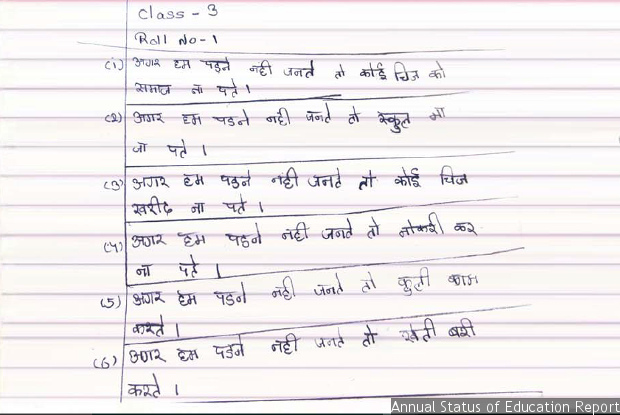BIMARU States: Little Progress In 2 Years, Learning Crisis For Millions Of Children
In 2016, some learning outcomes for 111 million school-age students between ages six and 15 remained mostly unchanged in BIMARU states (Bihar, Madhya Pradesh, Rajasthan and Uttar Pradesh), when compared to 2014, after declining for four years, according to the 2016 Annual Status of Education Report released in January 2017.
If the math and reading skills of these 111 million children--nearly half of India’s 252 million school-age children--cannot be improved, it is unlikely that India will be able to completely reap the demographic dividend from its working-age population of 1033 million by 2030--the largest of any country.
Here are the highlights of the new report:
- In Uttar Pradesh (UP), only 7.2% of grade III students in government schools could read a Grade II text; 7.9% could subtract two-digit sums (national average: 25.2% for reading, 27.7% for math)
- In Bihar, 75.2% of grade VIII children could read a grade II textbook in 2016 compared to 87.2% in 2010; 20.8% of grade III students could read a grade II text; 27.3% could subtract two-digit sums
- 23.7% of children in grade III in Rajasthan could read a level II text--the highest recorded in the last five years.
- Madhya Pradesh’s learning levels are the lowest in BIMARU states--16.6% of grade III children, 64.3% of grade VIII children could read a grade II text
Arithmetic Levels In Upper Primary School
Source: Annual Status of Education Report, 2016
Improvement in primary school reading; decline in upper primary
Though learning levels in MP are the lowest in BIMARU states, more children (16.6%) in grade III could read a grade II level text in 2016, compared to 2014 (14%), and 2010 (13.3%).
Similar improvements can be seen in Rajasthan and UP: 23.7% of grade III children in Rajasthan could read a grade II text in 2016, compared to 15.6% in 2010; in Uttar Pradesh, the percentage of children increased to 22.6% from 15.4%.
Primary school math levels have also improved in Madhya Pradesh. In 2016, 13.6% of grade III students could subtract compared to 10.6% in 2014, with more improvement in government schools than private schools.
Fewer Grade VIII children in MP could read a grade II textbook in 2016 (64.3%), than in 2014 (65.8%)--a drop from 2010, when 90.1% could read a grade II level text.
In Bihar, 20.8% of grade III students could read a grade II text in 2016, compared to 21.9% in 2014, mainly due to decline in learning levels of private school students.
The percentage of grade VIII children in UP, in private and public schools, who could read 8-10 lines from a grade II English textbook fell from 77.7% in 2010 to 67.8% in 2016.
Reading Levels In Primary School
Source: Annual Status of Education Report, 2016
Few teachers, toilets in schools
It is difficult to pinpoint reasons for the improvement or decline in learning outcomes, and reasons differ across states, Wilima Wadhwa, director of the ASER centre, told IndiaSpend. Still, indicators such as the pupil-teacher ratio have been linked with better learning outcomes.
While the prescribed pupil-teacher ratio (PTR), according to the Right to Education Act (RTE), is 30:1 for primary schools, and 35:1 for upper primary, only 11.7% of Bihar’s schools follow these guidelines--the lowest across India--a decline from 12.7% in 2014.
Though the PTR has improved in UP, with 30.9% of schools following RTE guidelines, compared to 16.1% schools in 2010, it is still one of the states with the lowest proportion of such schools in the country.
Source: Annual Status of Education Report, 2016
Lack of useable toilets have also been linked to falling learning outcomes, as children have to leave the school to use a toilet, and often do not return to class, according to this comment by the Centre for Policy Research, featured in The Hindu in September 2014.
Not many BIMARU schools have unlocked, usable toilets, ASER data show.
Overall, UP has the lowest number of schools equipped with useable toilets (54.8%) in India.
MP--the state which is reported to have constructed the second-most number of toilets, after Gujarat, in 2015--has 54% of schools with a separate, functioning toilet for girls, the lowest among the BIMARU states.
The story has been updated to reflect the correct working-age population and the year in which India will have the world's largest working-age population. The correct year is 2030 and not 2020, when India will have over a billion working-age people.
(Salve is an analyst, and Saldanha is an assistant editor with IndiaSpend.)
We welcome feedback. Please write to respond@indiaspend.org. We reserve the right to edit responses for language and grammar.
__________________________________________________________________
“Liked this story? Indiaspend.org is a non-profit, and we depend on readers like you to drive our public-interest journalism efforts. Donate Rs 500; Rs 1,000, Rs 2,000.”



